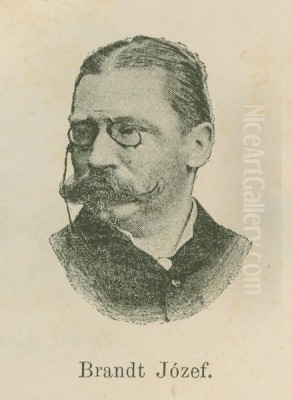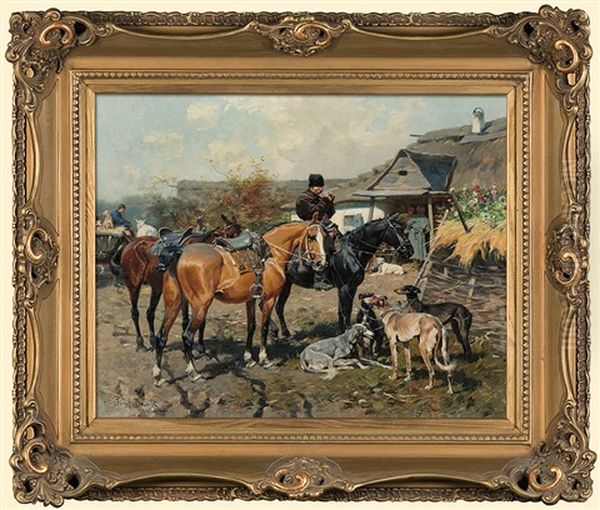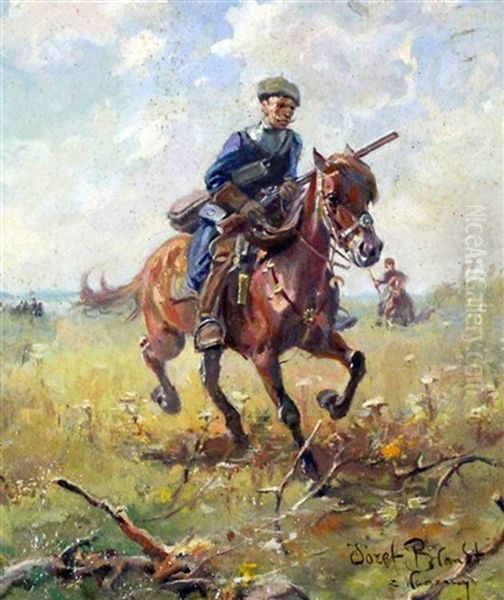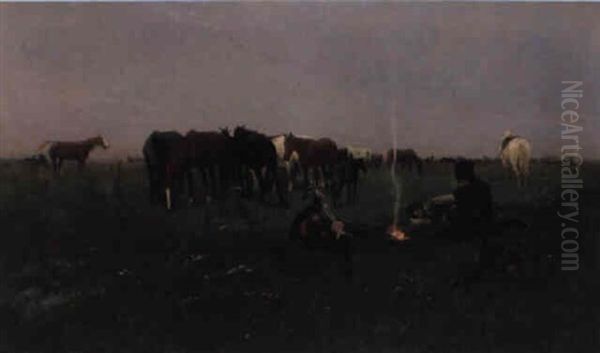
Józef Brandt stands as a towering figure in Polish art history, renowned primarily for his dramatic and meticulously detailed depictions of Polish military history, particularly from the 17th century. Born in Szczebrzeszyn in 1841 and passing away in Radom in 1915, Brandt's life spanned a tumultuous period for Poland, which was then partitioned among Russia, Prussia, and Austria. His art became a powerful vehicle for preserving national memory and celebrating Polish heroism, resonating deeply with a public yearning for symbols of past glory and independence. Though he spent much of his productive life in Munich, Germany, Brandt remained fiercely Polish, becoming a central figure in the influential "Munich School" of Polish painters.
Early Life and Artistic Awakening
Józef Brandt was born into an educated Warsaw family. His father was a respected physician, and his mother, an amateur painter herself, likely fostered his early interest in the arts. He received a solid education, attending the J.N. Leszczyński School and later the Institute for Nobles in Warsaw. Initially, his path seemed destined for a technical career rather than an artistic one.
In 1858, Brandt traveled to Paris, ostensibly to study engineering at the prestigious École Centrale des Arts et Manufactures. However, a fateful encounter in the French capital altered the course of his life. He met Juliusz Kossak, an established Polish painter already known for his historical and equine scenes. Kossak recognized Brandt's artistic talent and strongly encouraged him to abandon engineering in favor of painting. This advice proved pivotal. Brandt heeded Kossak's counsel and began dedicating himself to art.
While in Paris, Brandt sought out instruction to hone his skills. He took private lessons, focusing on drawing and painting fundamentals. This period laid the groundwork for his technical proficiency, although his most significant artistic development would occur later in Munich. The influence of Kossak, particularly in the choice of historical and equestrian themes, remained evident throughout Brandt's career.
Munich: The Formative Years

Seeking more formal and advanced training, Brandt relocated to Munich in 1862 (some sources state 1863). This move was crucial, as Munich had become a major European art center, attracting artists from across the continent, particularly Central and Eastern Europe. The city's Royal Academy of Fine Arts was renowned, and its liberal atmosphere offered opportunities often unavailable in the artists' home countries under stricter political regimes.
In Munich, Brandt enrolled in the private studio of Franz Adam, a noted German painter of battle scenes and horses. He further refined his skills under the tutelage of the highly influential history painter, Carl von Piloty, at the Academy. Piloty's emphasis on historical accuracy, dramatic composition, and rich detail profoundly shaped Brandt's approach. Studying under these masters provided Brandt with the technical arsenal needed to tackle the complex historical and military compositions that would become his hallmark.
Munich proved to be more than just a place of study for Brandt. In 1867, he established his own studio there, which quickly became a focal point for the growing community of Polish artists in the city. This group, often referred to as the Polish "colony" or the Munich School of Polish painters, included prominent figures who would significantly shape Polish art in the late 19th century. Brandt emerged as an informal leader and mentor within this circle.
His studio wasn't just a workspace but also a vibrant meeting place, filled with historical artifacts, weaponry, costumes, and equestrian gear that served as props for his paintings. He developed a close friendship with Theodor Hortal, an expert swordsman and collector, who provided Brandt with authentic historical items and insights, further enhancing the realism of his works. Brandt would remain based in Munich for most of his professional life, though his heart and artistic subjects remained firmly rooted in Poland.
Artistic Style and Themes
Józef Brandt's artistic style is best characterized as a compelling blend of Realism and Romanticism, applied predominantly to historical and military subjects. He possessed a remarkable ability to render details with precision – the intricate patterns on fabrics, the gleam of metal armour, the varied textures of horse hides, and the specific features of historical weaponry and attire. This commitment to accuracy lent his paintings an air of authenticity highly valued by his contemporaries.

However, Brandt infused this realism with a palpable romantic spirit. His compositions are often dynamic and filled with movement, capturing the chaos and energy of battle, the thunder of cavalry charges, or the lively bustle of historical scenes like market fairs. He masterfully depicted horses, capturing their anatomy, power, and grace in motion, making them central actors in his visual narratives. His use of color was rich and evocative, contributing to the dramatic atmosphere of his works.
A significant element in Brandt's style is Orientalism, reflecting Poland's historical position as a crossroads between East and West. His paintings frequently feature Cossacks, Tatars, and Ottoman Turks, often depicted as adversaries or exotic figures encountered on the Eastern borderlands (the Kresy) of the old Polish-Lithuanian Commonwealth. He meticulously researched and depicted their distinct costumes, weaponry, and physiognomies, adding an element of the exotic and highlighting Poland's historical role in conflicts and interactions along these frontiers.
Brandt's primary thematic focus was the military history of 17th-century Poland, a period marked by constant warfare but also seen as a golden age of Polish military prowess, particularly its famed cavalry. He painted scenes of battles, skirmishes, patrols, military camps, and the return of warriors from campaigns. These works often carried a strong undercurrent of patriotism and national pride, celebrating the bravery and resilience of Polish soldiers during a time when Poland itself did not exist as an independent state on the map of Europe.
Masterworks and Major Themes
Throughout his prolific career, Józef Brandt created numerous paintings that became iconic representations of Polish history. Among his most celebrated works is Odbiór jasyru, often translated as Taking Back the Spoils or Return from the Raid. This dynamic composition depicts Polish cavalry liberating captives from Tatar raiders on the vast steppe, showcasing dramatic action, skilled horsemanship, and intense emotion. It perfectly encapsulates Brandt's key themes: historical conflict, Polish heroism, and the atmosphere of the Eastern borderlands.
Another significant group of works revolves around the Lisowczycy, a famed unit of Polish light cavalry known for their speed, ferocity, and distinctive appearance. Paintings like Obóz lisowczyków (Lisowczycy Camp) and various depictions of their patrols and skirmishes capture the wild, almost nomadic spirit associated with these soldiers. These works highlight Brandt's fascination with irregular warfare and the unique character of Poland's historical military formations.

Brandt also tackled specific historical events and figures. Chodkiewicz at Chocim portrays the Polish-Lithuanian commander during the pivotal Battle of Chocim (1621) against the Ottoman Empire, a moment of significant historical pride. Works like Przejazdnicy (Cavalry Patrol or Riders) and Armia generała Tarnowskiego (General Tarnowski's Army) further explore themes of military life, movement, and historical leadership, often set against the backdrop of the expansive Eastern European landscapes.
His travels provided direct inspiration. Journeys through Ukraine in the late 1870s and early 1880s resulted in numerous sketches and watercolors capturing the landscapes, architecture, and people of regions like Podole, Bałta, and Kijów (Kyiv). These studies informed the settings of many of his larger oil paintings. Similarly, a commission from the Russian government took him to the Caucasus in the early 1880s, leading to a series of paintings depicting the region's life and conflicts, demonstrating his versatility beyond purely Polish themes, though always through his characteristic lens of detailed observation and dramatic composition.
The Munich Studio and Teaching Legacy
Józef Brandt's studio in Munich was more than just his personal workspace; it evolved into an unofficial academy for Polish artists drawn to the Bavarian capital. Brandt, by then an established and successful painter, naturally assumed the role of mentor and guide for many younger compatriots seeking to make their mark. His generosity with advice and his willingness to share his knowledge made him a central figure in the Polish artistic community abroad.
He directly taught or significantly influenced a generation of Polish painters. Among his most notable students was Maksymilian Gierymski, another key figure of the Munich School, known for his atmospheric landscapes and scenes of the 1863 January Uprising. Although Maksymilian's career was tragically short, his work, alongside Brandt's, helped define the character of Polish realism emanating from Munich. Other artists associated with Brandt's circle or the broader Polish Munich School included Maksymilian's brother, Aleksander Gierymski, the realist painter Józef Chełmoński, known for his dynamic depictions of Ukrainian landscapes and horses, and the portraitist Władysław Czachórski. Later figures like Leon Wyczółkowski also spent time in Munich.
Brandt's influence extended beyond direct tutelage. His success demonstrated that a Polish artist could achieve international recognition while focusing on national themes. His studio, filled with historical artifacts collected during his travels or acquired from friends like Theodor Hortal, provided an invaluable resource for artists striving for historical accuracy in their own works. The camaraderie and shared sense of Polish identity fostered within this Munich circle were crucial during a period of national statelessness.
His standing within the Munich art establishment was formally recognized. In 1878, he was appointed an honorary professor at the Munich Academy of Fine Arts, a testament to his artistic achievements and his importance within the city's cultural life. This position further solidified his role as a leading figure, bridging the Polish artistic community with the broader German and international art scene in Munich.
Connections and Contemporaries
Józef Brandt's artistic journey was shaped by interactions with numerous other artists, both Polish and international. His initial redirection towards art was famously prompted by Juliusz Kossak in Paris. While their styles evolved differently, the shared interest in Polish history and equestrian subjects created a lasting connection. Brandt's training under Franz Adam and Carl von Piloty in Munich was fundamental, grounding him in the techniques and aesthetics of German historical painting, which he adapted to his own national subjects.
Within the Polish Munich School, he was a central figure, interacting closely with Maksymilian and Aleksander Gierymski, Józef Chełmoński, and Władysław Czachórski, among others. These artists often shared themes and approaches, though each developed a distinct artistic personality. There was likely a degree of mutual influence and friendly rivalry within this group. Later in his career, Brandt is known to have collaborated on some works with the painter Władysław Szner, indicating continued engagement with fellow artists.
To understand Brandt's position in Polish art, it's essential to consider him alongside other major Polish historical painters of the era. Jan Matejko, based primarily in Kraków, was the dominant figure in Polish historical painting, known for his monumental canvases depicting key moments in Polish history with intense patriotic fervor. While both Brandt and Matejko aimed to bolster national spirit, Matejko's style was often more symbolic and allegorical, whereas Brandt focused more on the realistic depiction of military life and specific types of historical scenes, particularly those involving cavalry and the Eastern borderlands. Henryk Siemiradzki, another contemporary, achieved fame working in Rome, specializing in grand scenes from antiquity, representing a more academic and cosmopolitan strand of historical painting.
Brandt's long residence in Munich also placed him in proximity to leading German artists associated with the Munich School, such as the portraitist Franz von Lenbach or the realist Wilhelm Leibl, although his primary artistic community remained the Polish contingent. His participation in international exhibitions in Berlin, Vienna, Paris (including the Exposition Universelle), and St. Petersburg brought his work to a wider audience and placed it in dialogue with broader European art trends.
Later Life, Recognition, and Controversy
Józef Brandt enjoyed considerable success and recognition during his lifetime. His paintings were popular with collectors both in Poland and abroad, particularly in Germany and Austria. He exhibited widely and received numerous awards and honors at international exhibitions, solidifying his reputation as a leading European painter of historical and military scenes. His appointment as an honorary professor in Munich and other accolades confirmed his esteemed status.
He maintained strong ties to Poland, spending summers at his estate in Orońsko near Radom, which also became an artistic retreat. In 1876, he married Helena Woyciechowska Pruszakowa, and the couple had two children. Despite his long-term residency in Munich, Brandt consistently emphasized his Polish identity, often signing his paintings "Józef Brandt z Warszawy" (Józef Brandt from Warsaw).
His life was not without challenges. In 1894, a fire damaged his Munich residence, causing personal and professional disruption. Around the same time, he was actively involved in managing the Polish Artists' Aid Society in Munich, demonstrating his commitment to supporting his fellow countrymen. He also continued to travel and paint, and in 1903, published notes from his travels in Galicia, offering insights into his working methods and interests.
While highly acclaimed, Brandt's work was not immune to criticism. Some contemporary and later critics found his style repetitive or overly focused on anecdotal detail, occasionally lacking deeper psychological insight or compositional innovation compared to some of his peers. His immense popularity also led to accusations of commercialism from some quarters. Furthermore, his depiction of Ukrainian themes and landscapes, while based on his travels, sometimes sparked discussions about cultural representation, particularly regarding the integration of these elements within a predominantly Polish historical narrative.
Despite these critiques, Brandt's reputation endured. Retrospective exhibitions, including significant ones held long after his death (e.g., in 1926, 1987, and 2018), have reaffirmed his importance. His works remain highly sought after and are held in major museums in Poland and internationally. He passed away in Radom, Poland, in 1915.
Legacy and Conclusion
Józef Brandt occupies a vital place in the history of Polish art. As a leading member of the Munich School, he played a crucial role in shaping the course of Polish realism in the late 19th century. His mastery in depicting horses, dynamic battle scenes, and the specific details of 17th-century Polish military life set a standard for historical painting. His works provided a powerful visual connection to a heroic past for a nation struggling under foreign partition.
His influence extended through his teaching and mentorship, helping to nurture the talents of other significant Polish artists in Munich. His studio served as an important cultural hub, fostering a sense of community and shared purpose among Polish artists abroad. Brandt successfully navigated the international art market while remaining dedicated to Polish national themes, demonstrating that artistic excellence and patriotic sentiment could go hand in hand.
While critical perspectives on his work have evolved, his skill as a painter, his dedication to historical accuracy (as understood in his time), and the sheer energy and visual appeal of his canvases remain undeniable. Józef Brandt's paintings continue to captivate audiences with their detailed realism, romantic flair, and evocative portrayal of a bygone era of Polish history, securing his legacy as a master chronicler of Poland's martial past and a key figure of the Munich School.